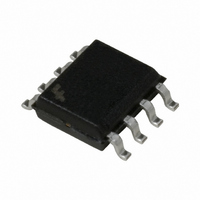ACE1202LEM8X Fairchild Semiconductor, ACE1202LEM8X Datasheet - Page 28

ACE1202LEM8X
Manufacturer Part Number
ACE1202LEM8X
Description
IC MCU 2KBIT EEPROM 8SOIC
Manufacturer
Fairchild Semiconductor
Series
ACEX® 12xxr
Datasheet
1.ACE1202EMX.pdf
(39 pages)
Specifications of ACE1202LEM8X
Core Processor
ACE1202
Core Size
8-Bit
Speed
4MHz
Peripherals
Brown-out Detect/Reset, LVD, POR, PWM, WDT
Number Of I /o
6
Program Memory Size
2KB (2K x 8)
Program Memory Type
EEPROM
Eeprom Size
64 x 8
Ram Size
64 x 8
Voltage - Supply (vcc/vdd)
1.8 V ~ 5.5 V
Oscillator Type
Internal
Operating Temperature
-40°C ~ 85°C
Package / Case
8-SOIC (3.9mm Width)
Lead Free Status / RoHS Status
Lead free / RoHS Compliant
Data Converters
-
Connectivity
-
ACE1202 Product Family Rev. B.1
The Multi-Input Wakeup (MIW)/Interrupt contains three memory-mapped
registers associated with this circuit: WKEDG (Wakeup Edge), WKEN
(Wakeup Enable), and WKPND (Wakeup Pending). Each register has
8-bits with each bit corresponding to an input pins as shown in Figure
26. All three registers are initialized to zero upon reset.
The WKEDG register establishes the edge sensitivity for each of
the wake-up input pin: either positive going-edge (0) or negative-
going edge (1).
The WKEN register enables (1) or disables (0) each of the port
pins for the Wakeup/Interrupt function. The wakeup I/Os used for
the Wakeup/Interrupt function must also be configured as an input
pin in its associated port configuration register. However, an
interrupt of the core will not occur unless interrupts are enabled for
the block via bit 7 of the T0CNTRL register (see Figure 19) and the
G (global interrupt enable) bit of the SR is set.
The WKPND register contains the pending flags corresponding to
each of the port pins (1 for wakeup/interrupt pending, 0 for
wakeup/interrupt not pending).
To use the Multi-Input Wakeup/Interrupt circuit, perform the steps listed
below. Performing the steps in the order shown will prevent false
triggering of a Wakeup/Interrupt condition. This same procedure
should be used following any type of reset because the wakeup inputs
are left floating after resets resulting in unknown data on the port inputs.
1. Clear the WKEN register.
2. If necessary, write to the port configuration register to select
3. If necessary, write to the port data register to select the
4. Write the WKEDG register to select the desired type of edge
5. Clear the WKPND register to cancel any pending bits.
11
12
Available only on the 14-pin package option
WKINTEN: Bit 7 of T0CNTRL
- CLR WKEN
the desired port pins to be configured as inputs.
- RBIT 4, PORTGC
desired port pins input state.
- SBIT 4, PORTGD
sensitivity for each of the pins used.
- LD WKEDG, #0FFH
- CLR WKPND
Bit 7
11
G7
G0
G7
Bit 6
WKEDG[0:7]
11
G6
; G4
; Pull-up
; All negative-going edges
WKPND[0:7]
Bit 5
G5
Data Bus
0
7
7
WKEDG, WKEN, WKPND
WKEN[7:0]
Bit 4
G4
0
6. Set the WKEN bits associated with the pins to be used, thus
Once the Multi-Input Wakeup/Interrupt function has been config-
ured, a transition sensed on any of the I/O pins will set the
corresponding bit in the WKPND register. The WKPND bits , where
the corresponding enable (WKEN ) bits are set, will bring the device
out of the HALT mode and can also trigger an interrupt if interrupts
are enabled. The interrupt service routine can read the WKPND
register to determine which pin sensed the interrupt.
The interrupt service routine or other software should clear the
pending bit. The device will not enter HALT mode as long as a
WKPND pending bit is pending and enabled. The user has the
responsibility of clearing the pending flags before attempting to
enter the HALT mode.
Upon reset, the WKEDG register is configured to select positive-
going edge sensitivity for all wakeup inputs. If the user wishes to
change the edge sensitivity of a port pin, use the following proce-
dure to avoid false triggering of a Wakeup/Interrupt condition.
1. Clear the WKEN bit associated with the pin to disable that pin.
2. Write the WKEDG register to select the new type of edge
3. Clear the WKPND bit associated with the pin.
4. Set the WKEN bit associated with the pin to re-enable it.
PORTG provides the user with three fully selectable, edge sensi-
tive interrupts that are all vectored into the same service subrou-
tine. The interrupt from PORTG shares logic with the wakeup
circuitry. The WKEN register allows interrupts from PORTG to be
individually enabled or disabled. The WKEDG register specifies
the trigger condition to be either a positive or a negative edge. The
WKPND register latches in the pending trigger conditions.
Since PORTG is also used for exiting the device from the HALT mode,
the user can elect to exit the HALT mode either with or without the interrupt
enabled. If the user elects to disable the interrupt, then the device restarts
execution from the point at which it was stopped (first instruction cycle of
the instruction following HALT mode entrance instruction). In the other
case, the device finishes the instruction that was being executed when the
part was stopped and then branches to the interrupt service routine. The
device then reverts to normal operation.
enabling those pins for the Wakeup/Interrupt function.
- LD WKEN, #10H
sensitivity for the pin.
Bit 3
G3
WKINTEN
11
Bit 2
G2
; Enabling G4
Bit 1
G1
WKOUT
EDGEI
www.fairchildsemi.com
Bit 0
G0











